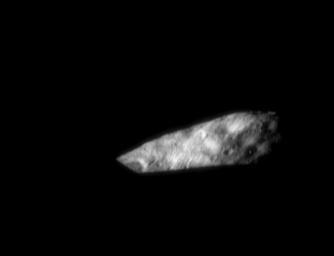
|
Sunset on Eros
- Click the image above for a larger view
- Full-Res JPEG (537 x 412) (5.9 kB)
- Full-Res TIFF (537 x 412) (25.8 kB)
Caption:
Eros' irregular shape gives rise to some stunning vistas at the time of sunrise or sunset. On March 6, 2000, the imager on the NEAR Shoemaker spacecraft caught this view of a stunning sunset. In the pitch black foreground the Sun has already set, but just over the horizon another part of the asteroid remains lit. Eros' rotation period is just 5 hours, 16 minutes, so in the course one 24-hour Earth day an observer on Eros would be treated to four full cycles of sunrises and sunsets.
Background Info:
Built and managed by The Johns Hopkins University Applied Physics Laboratory, Laurel, Maryland, NEAR was the first spacecraft launched in NASA's Discovery Program of low-cost, small-scale planetary missions. See the NEAR web page at http://near.jhuapl.edu/ for more details.
Cataloging Keywords:
| Name | Value | Additional Values |
|---|---|---|
| Target | 433 Eros | |
| System | Near Earth Objects | |
| Target Type | Asteroid | |
| Mission | NEAR Shoemaker | |
| Instrument Host | NEAR Shoemaker | |
| Host Type | Orbiter | |
| Instrument | Multi-Spectral Imager (MSI) | |
| Detector | ||
| Extra Keywords | Grayscale, Rotation | |
| Acquisition Date | ||
| Release Date | 2000-06-10 | |
| Date in Caption | 2000-03-06 | |
| Image Credit | NASA/JPL/JHUAPL | |
| Source | photojournal.jpl.nasa.gov/catalog/PIA02493 | |
| Identifier | PIA02493 | |
